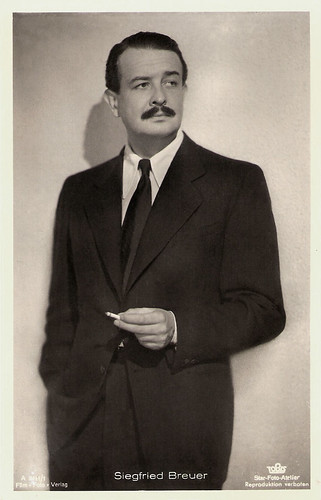
German postcard by Film-Foto-Verlag, no. A 3441/1, 1941-1944. Photo: Star-Foto-Atelier / Tobis.
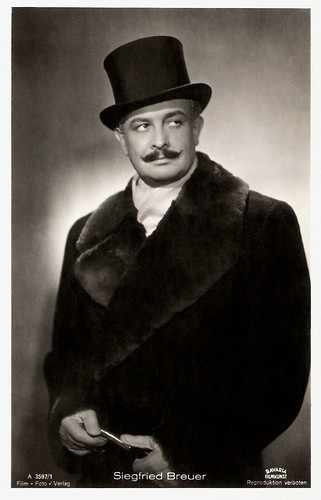
German postcard by Film-Foto-Verlag, no. A 3597/1, 1941-1944. Photo: Bavaria Filmkunst.
An elegant but sinister seducer
Siegfried Breuer was born in Vienna, Austria in 1906. He was the son of the German actor and opera singer Hans Breuer. His godfather was Siegfried Wagner. So performing was in young Siegfried’s blood. In the early 1920s, he attended the Akademie für Musik und Darstellende Kunst (Academy of Music and Performing Arts) in Vienna, where he studied alongside Paula Wessely and Käthe Gold.
In 1924, he made his stage debut at the Volkstheater in Vienna and later played there at the Theater in der Josefstadt. In Berlin, he performed his first leading role in the classic play Der Prinz von Homburg (The Prince of Homburg) by Heinrich von Kleist under the direction of Max Reinhardt. In 1935 he became a permanent member of the ensemble cast of Reinhardt's prestigious Deutschen Theaters (till 1941). After some 15 years of stage acting the then 33 years old Siegfried Breuer made his screen debut in the short Eins zu Eins/One to One (Carl Prucker, 1939). However, in 1931 he had already played a bit part in the comedy Wochenend im Paradies/Weekend in Paradise (Robert Land, 1931) starring Trude Berliner.
He was immediately much in demand, and that same year, he added his Viennese charm to Unsterblicher Walzer/Immortal Waltz (E.W. Emo, 1939) with Paul Hörbiger as Johann Strauss, Mutterliebe/Mother Love (Gustav Ucicky, 1939), the comedy Anton, der Letzte/Anthony the Last (E.W. Emo, 1939) with Hans Moser, and the Anti-Semitic Nazi propaganda film Leinen aus Irland/Linen for Ireland (Heinz Helbig, 1939).
During the war years, Breuer played an elegant but sinister seducer in the Alexander Pushkin adaptation Der Postmeister/The Postmaster (Gustav Ucicky, 1940) with Heinrich George and Hilde Krahl, and in the classic Romanze in Moll/Romance in Moll (Helmut Käutner, 1943) with Marianne Hoppe.
But he also served the stereotype of the evil Jew in such anti-Semitic productions as Der Weg ins Freie/The way out (Rolf Hansen, 1941) starring Zarah Leander, and Venus vor Gericht/Venus in court (Hans H. Zerlett, 1941) with Hannes Stelzer.

German postcard by FBZ (Film-Bild-Zentrale). Photo: Binz.
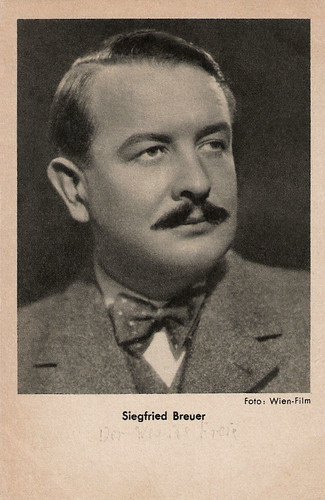
German postcard by Das Programm von Heute. Photo: Wien-Film.
Harry Lime's friend
Between 1939 and 1954, Siegfried Breuer would star in 50 films. After the war, he was seen in a supporting part in the colour film adaptation of the operetta Die Fledermaus/The Bat (Géza von Bolváry, 1946) with Marte Harell and Johannes Heesters. Die Fledermaus was already shot in 1944, but the film material seemed lost after the bombings. In 1946, the material was found and finally edited.
One of the most famous films in which Breuer appeared is the British film noir The Third Man (Carol Reed, 1949), situated in allied-occupied Vienna. Breuer played the Romanian Popescu, one of the black marketers and friends of the mysteriously killed Harry Lime (Orson Welles). Popescu was a small part but one which is integral to the development of the story.
Another success was the come-back film of Zarah Leander, the musical drama Gabriela (Géza von Cziffra, 1950), co-starring Carl Raddatz, Vera Molnar and Breuer. Gabriela was the third highest-grossing film at the West German box office in 1950.
Breuer directed, wrote and starred in the film Der Schuß durchs Fenster/The Shot through the Window (Siegfried Breuer, 1950) in which he worked with Curd Jürgens. He also directed the comedies Seitensprünge im Schnee/Escapades in the Snow (Siegfried Breuer, 1950) with Doris Kirchner, and In München steht ein Hofbräuhaus/In Munich stands a Hofbräuhaus (Siegfried Breuer, 1951) with Fita Benkhoff and Paul Kemp.
Siegfried Breuer was a heavy smoker. He died of a combination of liver disease and pneumonia in 1954 in Weende near Göttingen in the South of Germany. He was only 47. Breuer was married six times, among others with the actresses Maria Andergast, Eva-Maria Meineke and Lia Condrus. His sons Walter Breuer a.k.a. Siegfried Breuer Jr. and Wolfgang Breuer a.k.a. Wolfgang Condrus and his grandchildren Jacques Breuer and Pascal Breuer also worked in the entertainment industry.
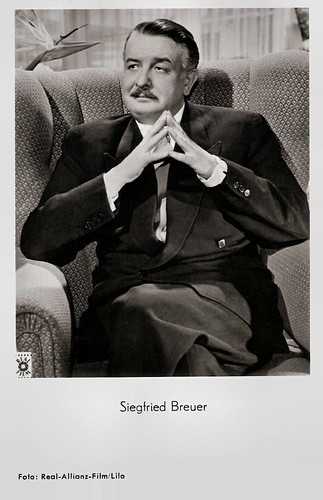
German postcard by Film-Postkartenverlag, Hamburg-Bergedorf, no. 120. Photo: Real-Film. Publcity still for Gabriela (Géza von Cziffra, 1950).
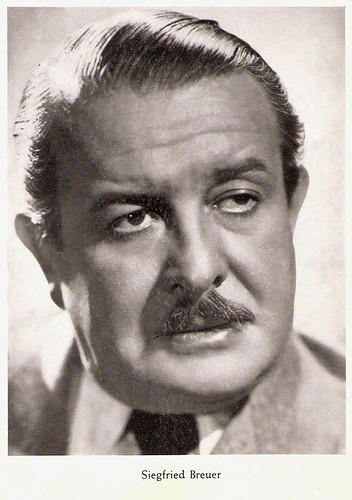
German collectors card.
Sources: I.S. Mowis (IMDb), Stephanie D'heil (Steffi-line) (German), Wikipedia (English and German), and IMDb.
This post was last updated on 9 August 2023.
No comments:
Post a Comment